Conducted immunity[edit]
Introduction[edit]
Conducted immunity tests are a simulation of RF currents in cables, induced by RF fields of transmitters working in the lower frequency bands. At frequencies below 30 MHz it is quite difficult to generate an RF field in an anechoic chamber. This is caused by the fact that the wavelength of the test signal becomes increasingly longer at lower frequencies (l [m]= 300 / f
[MHz]) and therefore, the transmitting antenna becomes either very long (± 5 meter at 30 MHz) or very in-efficient.
The dimensions of most anechoic chambers do not allow antennas greater than 5 meter (labda / 2). On the other hand, when smaller antennas are used, the power needed to generate a field becomes very high. At 30 MHz with a 3 meter EUT, Antenna separation, a transmitted power of approximately 500 W is needed. For frequencies below 30 MHz the desired power
rapidly increases to several Kilowatts. During conducted immunity tests, a RF current is injected in to the cabling of the equipment under test. Different EMC standards use different methods to control the injected current.
The RadiMation® test software supports four different methods for current injection.
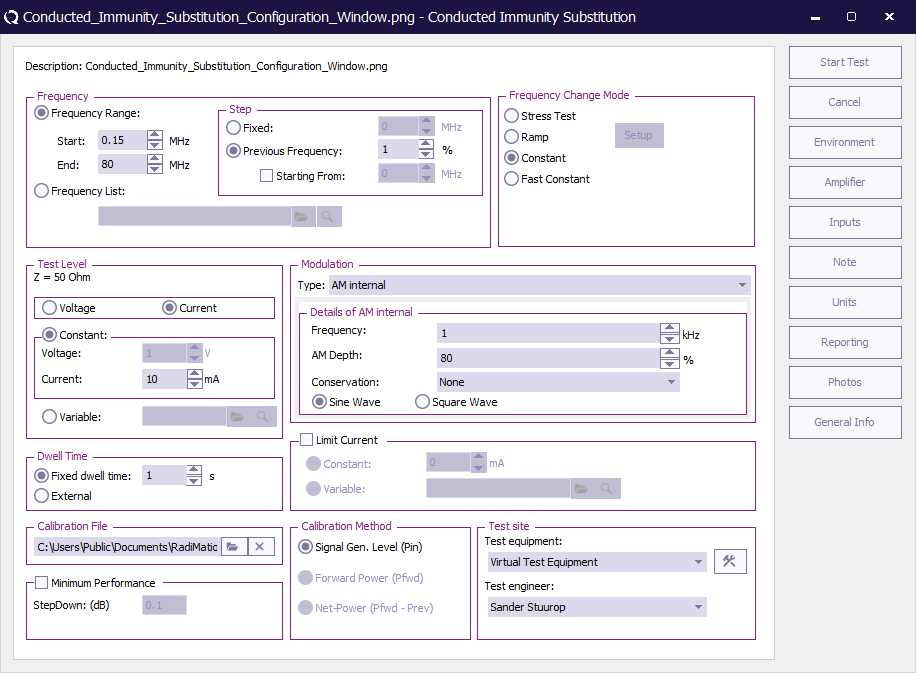
Substitution method[edit]
During current injection tests according to the substitution method, a constant voltage is applied to the injection clamp.
-
 Tests
Tests
-
 Conducted Immunity
Conducted Immunity
-
 Substitution
Substitution
Related standards are:
EN 61000-4-6[edit]
For tests in accordance to EN 61000-4-6 a CDN (Coupling Decoupling Network) or injection clamp with characteristic impedance of 150 Ω is used. Before actual tests can take place, calibration of the test set-up is required. See the “Calibration” chapter for the method to calibrate the current clamp. During the calibration, a calibration file is made, which contains the drive levels for each test frequency. The values recorded in the calibration file are the forward power levels to the clamp, necessary to inject a constant current into a 150 Ω reference wire. For example, if a test level of 10 Vrms has to be injected, a current of 33 mA is injected in the 150 Ω reference wire (10 Vrms / (150 Ω + 150 Ω)).
After the test set-up has been calibrated, tests can be performed using the calibration file.
The current injected into the cabling of the EUT (Equipment Under Test) during a test, will be determined by the impedance of the cable and the 150 Ω of the injection clamp. Worst case, the injected current will be twice as high as the injected current during the calibration.
95/54/EEG[edit]
Tests for automotive and military applications often are referred to as Bulk Current Injection (BCI) tests. For tests in accordance to 95/54/EEG a Bulk Current Injection clamp is used. Before actual tests can take place, calibration of the test set-up is required.
Chapter 12 describes the method for the calibration of the bulk current injection set-up. During the calibration, a calibration file is made, which contains the drive levels for each test frequency. The values recorded in the calibration file are the forward power levels to the clamp, necessary to inject a constant current into a 100 Ω calibration Jig.
After the test set-up has been calibrated, tests can be performed using the calibration file.
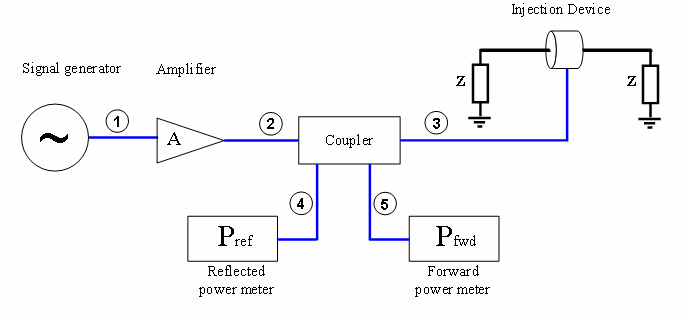
| # |
Device name |
Tab in RadiMation® configuration window
|
|
Signal Generator |
Devices 1
|
|
Forward power meter |
Devices 1
|
|
Amplifier |
Devices 1
|
|
Coupler |
Devices 1
|
|
Reflected power meter |
Devices 1
|
|
Injection device |
Devices 2
|
| Cables
|
| 1 |
Cable SG -> Amplifier |
Cables
|
| 2 |
Cable Amplifier -> coupler |
Cables
|
| 3 |
Cable Coupler -> Antenna |
Cables
|
| 4 |
Cable Coupler -> fwd Power meter |
Cables
|
| 5 |
Cable Coupler -> refl power meter |
Cables
|

|
Note:
|
Usage of cable correction factors is not mandatory. However, using correction factors will increase measurement accuracy during immunity measurements.
Although, during immunity measurements according to the substitution method, cable correction factors will increase the accuracy of measured/displayed power values. The generated field accuracy will however be the same when using correction factors or not.
When in doubt contact your reseller.
|
Current levelling method[edit]
-
 Tests
Tests
-
 Conducted Immunity
Conducted Immunity
-
 Fixed Current
Fixed Current
During conducted immunity tests according to the "current levelling" method, the injected current during the tests is real time levelled to the desired value. For "current levelling" tests, no calibration files are required. Some EMC standards, like automotive standards, describe current levelling test methods.
Some EMC standards prescribe the use of a selective power meter like a spectrum analyser. A selective power meter will only measure the fundamental frequency of the injected current, where a broad band power meter measures the fundamental frequency with all of its harmonics. On the other hand, a broadband power meter is much more accurate than the amplitude accuracy of a spectrum analyser. RadiMation® supports both the use of spectrum analysers and power meters simply by selecting the corresponding power meter device driver.
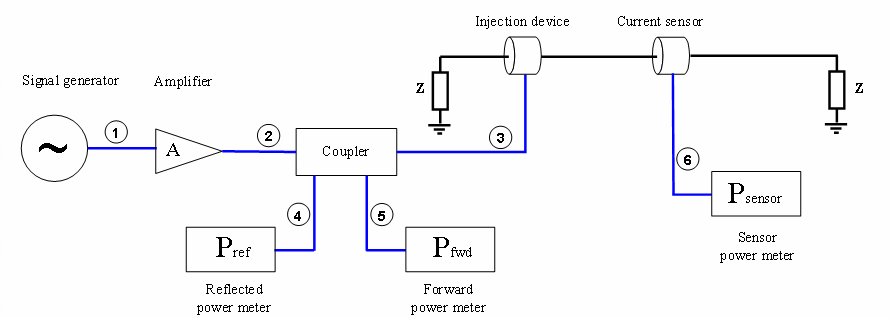
| # |
Device name |
Tab in RadiMation® configuration window
|
|
Signal Generator |
Devices 1
|
|
Amplifier |
Devices 1
|
|
Coupler |
Devices 1
|
|
Forward power meter |
Devices 1
|
|
Reflected Power meter |
Devices 1
|
|
Injection device |
Devices 2
|
|
Current sensor |
Devices 2
|
|
Sensor power meter |
Devices 2
|
| Cables
|
| 1 |
Cable SG -> Amplifier |
Cables
|
| 2 |
Cable Amplifier -> Coupler |
Cables
|
| 3 |
Cable Coupler -> Antenna |
Cables
|
| 4 |
Cable Coupler -> Fwd Power meter |
Cables
|
| 5 |
Cable Coupler -> Refl Power Meter |
Cables
|
| 6 |
Cable Current -> Power Meter |
Cables
|

|
Note:
|
Usage of cable correction factors is not mandatory. However, using correction factors will increase measurement accuracy during immunity measurements.
When in doubt contact your reseller.
|
Fixed Power method[edit]
Fixed generator tests can be useful during various kinds of EMC tests. During current injection tests, this method can be used to achieve the maximum injected current the amplifier is able to generate. Although this will not be a constant current over the frequency range, it can be useful during engineering work.
-
 Tests
Tests
-
 Conducted Immunity
Conducted Immunity
-
 Fixed Power
Fixed Power
Fixed generator tests can be performed in three different ways:
Fixed signal generator output level. Tests with a fixed generator output level do not take cable losses and amplifier frequency response into account. No power meters are needed during these tests and therefore, the test speed is higher than the fixed forward and fixed transmitted power tests. Fixed Forward power level Tests with a fixed forward power level do take cable losses and amplifier frequency response into account. One power meter is required during these tests. This test method does not take VSWR mismatch between the amplifier and current probe into account (i.e.: the forward power and transfer impedance of the current probe alone is not enough to calculate the actually injected current). Tests with a fixed transmitted power level take cable losses, amplifier frequency response and VSWR mismatch into account. Two power meters are required during these tests, one to measure the forward power, and one to measure the reflected power. The difference between forward power and reflected power is the transmitted power.
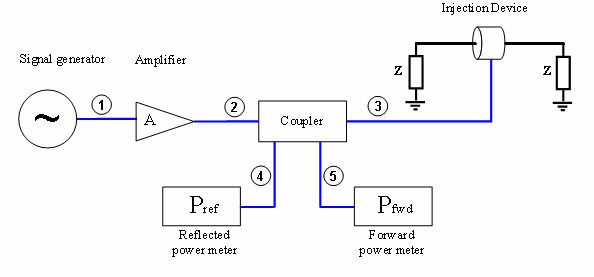
| # |
Device name |
Tab in RadiMation® configuration window
|
|
Signal Generator |
Devices 1
|
|
Amplifier |
Devices 1
|
|
Coupler |
Devices 1
|
|
Forward power meter |
Devices 1
|
|
Reflected power meter |
Devices 1
|
|
Injection device |
Devices 2
|
| Cables
|
| 1 |
Cable SG -> Amplifier |
Cables
|
| 2 |
Cable Amplifier -> Coupler |
Cables
|
| 3 |
Cable Coupler -> Antenna |
Cables
|
| 4 |
Cable Coupler -> Fwd Power Meter |
Cables
|
| 5 |
Cable Coupler -> Refl Power Meter |
Cables
|

|
Note:
|
Usage of cable correction factors is not mandatory. However, using correction factors will increase measurement accuracy during immunity
measurements.
When in doubt contact your reseller.
|
Minimum performance method[edit]
The RadiMation® package also supports a specific method to determine the minimum performance level of a Device Under Test. This method differentiates itself from the aforementioned methods in that it does not generate a fixed specified injected current but a varying injected current based on the susceptibility of the Device Under Test.
-
 Tests
Tests
-
 Conducted Immunity
Conducted Immunity
-
 Minimum Performance
Minimum Performance
The method relies heavily on EUT monitoring (see chapter 10) to determine at which level the Device Under Test is influenced. Before the test is started the relevant A/D-channels have to be configured. Pushing the input button on the configuration screen does this.
The test is started at a (low) injection level after which the current is increased with a specified increment until either of the following situations arises. The current is limited by amplifier protection or the Device Under Test will be influenced in such way that the specified limits are exceeded. The field strength is then reduced with a specified step and the software will change to the next frequency point. This test will result in a graph showing the level to which the Device Under Test is unaffected by a current injection.
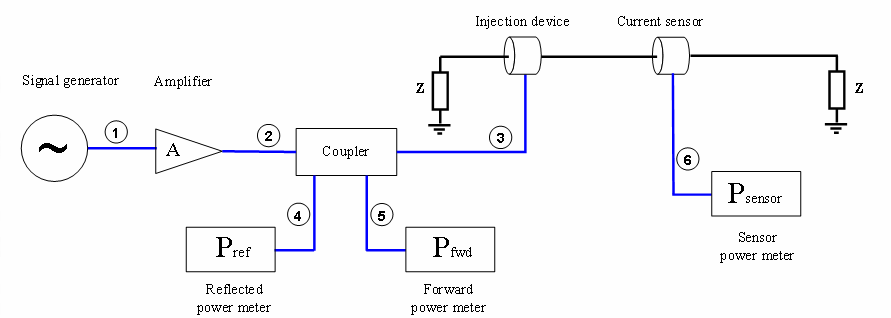
| # |
Device name |
Tab in RadiMation® configuration window
|
|
Signal Generator |
Devices 1
|
|
Amplifier |
Devices 1
|
|
Coupler |
Devices 1
|
|
Forward Power meter |
Devices 1
|
|
reflected Power meter |
Devices 1
|
|
Injection device |
Devices 2
|
|
Current sensor |
Devices 2
|
|
Sensor power meter |
Devices 2
|
| Cables
|
| 1 |
Cable SG -> Amplifier |
Cables
|
| 2 |
Cable Amplifier -> Coupler |
Cables
|
| 3 |
Cable Coupler -> Antenna |
Cables
|
| 4 |
Cable Coupler -> Fwd Power Meter |
Cables
|
| 5 |
Cable Coupler -> Refl Power Meter |
Cables
|
| 6 |
Cable Current -> Power Meter |
Cables
|

|
Note:
|
The current sensor, the sensor power meter and cable only need to be inserted when current limiting is selected. When not selected usage of these devices will be omitted.
|

|
Note:
|
Usage of cable correction factors is not mandatory. However, using correction factors will increase measurement accuracy during immunity measurements.
When in doubt contact your reseller.
|
Calibration methods[edit]
RadiMation® supports three different ways of power calibration. During the configuration of the calibration, the desired method should be selected. During a test, when a calibration file is selected, RadiMation® will automatically select the method that was used during calibration.
Signal generator level calibration[edit]
When a signal generator level calibration is used, only the signal generator level is recorded during the calibration. During a test, the signal power that was recorded during a calibration will be re-established. This method does not take amplifier instability or fluctuation into account. During this calibration method no forward and reflected powermeters are required. This method is less accurate than the Forward power and Net power calibrations and therefore is not recommended for full compliance tests. Because no powermeters are used, this method is the fastest method to perform a test.
Forward power calibration[edit]
During a Forward power calibration, the forward power to the transmitting antenna is recorded. During a test, the Forward power to the antenna is kept the same as during the calibration. When this method is used, amplifier drift will have no influence on the test, because the same output power out of the amplifier is re-established as was present during the calibration.
Net power calibration[edit]
During a Net power calibration, the Forward and Reflected power to the antenna are recorded. The difference between the Forward power and Reflected power is the Transmitted power. When net power is calibrated, then during the test, the transmitted power by the antenna is kept the same as during calibration. This method has the advantage, that the transmitted power is adjusted to be the same as during the calibration, also when a large metallic EUT is placed in front of the antenna. In that situation some RF energy can be reflected back into the antenna, resulting in a worse VSWR. If in this situation a forward power calibration or a signal generator level calibration was used, this effect is not compensated for. When net power is calibrated, the power transmitted by the antenna is kept the same as during calibration. When a net power calibration is made, this calibration file can also be used to perform a signal generator substitution test or a forward power substitution test. During a forward power calibration, the signal generator level, forward power level and the field strength during calibration is recorded.
Short cut keys in manual mode[edit]
The following short cut keys can be used during manual mode.
| Key |
Function
|
| Up |
Carrier level up.
|
| Down |
Carrier level down.
|
| Left |
Carrier frequency down.
|
| Right |
Carrier frequency up.
|
| N,n |
Set carrier on.
|
| F,f |
Set carrier off.
|
Tolerance[edit]
For every conducted immunity test you can define a tolerance. This tolerance has great effect on the measurement. If you choose the tolerance too large then the test results are not usable, if you choose the tolerance too small then it could be that RadiMation® has problems performing the test correctly. For example if you define a tolerance of 0.1 dB and your system is only capable of measuring with an uncertainty of 0.2dB then it could be that you get a very large event log. So what does it really mean, this tolerance? The best way is to explain by using an example. Suppose you are performing a fixed power test, leveling is set on netpower. You have told RadiMation® to generate 50 dBm with a tolerance of 0.2 dB. When RadiMation® is leveling the power it will accept any power level between 50 and 50.2 dBm as a correct leveled value, and will continue with the test.
Multiband[edit]
Test levels[edit]
In RadiMation’s MultiBand testing modules, "test levels" are settings that control how power is regulated, limited, and measured during EMC testing. They play a crucial role in ensuring that devices under test are exposed to consistent and precise levels across multiple frequency bands. Here’s how test levels work and how they affect your testing process in RadiMation:
Types of Test Levels[edit]
In RadiMation’s MultiBand modules, there are different types of test levels that each serve a unique purpose during testing:
- Power Leveling (Test Level): This type of test level sets the target power level that the test equipment should aim to achieve. It ensures that a specific level of electromagnetic energy is consistently applied to the device under test.
- Power Limitation (Limit Level): This is used to cap the maximum power level that the system can apply. By setting limit levels, you ensure that the power applied never exceeds safe or specified levels, helping to protect the device under test from overexposure.
- Measurement Inputs (Input Level): Input levels define what measurements are necessary during the test. For instance, they can specify particular signals or parameters that the system should measure at specific points during the test, allowing you to monitor the test environment and the device's behavior closely.
How Test Levels Are Applied[edit]
Test levels in RadiMation can be configured to suit the specifics of your testing requirements. Each test level can have its own configuration, and the RadiMation software allows you to select and adjust these levels within the test module’s interface. For example, you can set different test levels for different frequency bands, helping to simulate various conditions that the device might encounter.
When setting up a test in a MultiBand module, you’ll be able to choose a test level from RadiMation’s built-in list of available test levels for a given module. Once a test level is selected, the system will:
- Regulate Power: If you selected a power leveling type, the system will continuously adjust to maintain the specified power level during the test.
- Enforce Limits: If you set a limit level, RadiMation will prevent the power from exceeding this limit, which can be especially useful when testing devices with sensitive components.
- Measure Inputs: For input levels, the system will capture and log the specified measurement data. This data will become available in the test data and can be used for further visualization and reporting.
RadiMation’s MultiBand modules also allow you to set up multiple test levels for a single test. This flexibility enables you to create complex testing scenarios.
Test levels in RadiMation’s MultiBand modules are essential settings for regulating, limiting, and measuring the levels to which the devices under test are submitted. By configuring these levels appropriately, you can ensure accurate and effective testing outcomes.
Available test levels[edit]
Test level: Power closed loop method[edit]
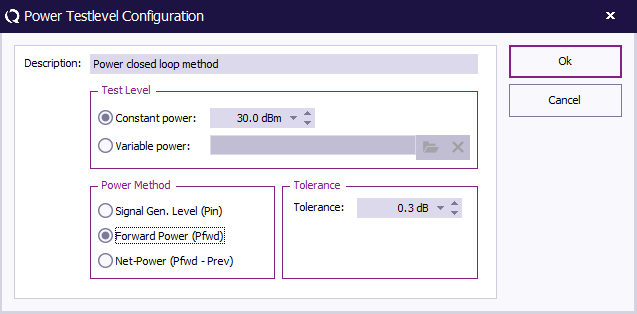
 Description Description
|
A field to enter a description for the power test level method being configured.
|
 Constant Power Constant Power
|
A test level option where the power is kept constant at a specified level, in this case, -100.0 dBm.
|
 Variable Power Variable Power
|
An option to set a range or variable power level for testing. This option is disabled in the image.
|
 Signal Gen. Level (Pin) Signal Gen. Level (Pin)
|
A power method that uses the signal generator level (Pin) as the reference for power measurement.
|
 Forward Power (Pfwd) Forward Power (Pfwd)
|
A power method that uses the forward power (Pfwd) as the reference for power measurement.
|
 Net-Power (Pfwd - Prev) Net-Power (Pfwd - Prev)
|
A power method that calculates net power by subtracting the previous power level (Prev) from the forward power (Pfwd).
|
 Tolerance Tolerance
|
A field to set a tolerance level for power measurement in dB, which defines the acceptable variation range.
|
Test level: Current closed loop method[edit]
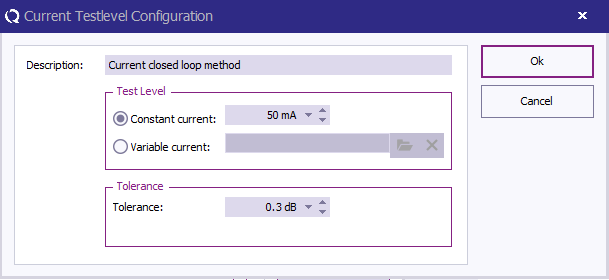
 Description Description
|
A field to enter a description for the current closed loop test level method being configured.
|
 Constant Current Constant Current
|
A test level option where the current is kept constant at a specified level, in this case, 50 mA.
|
 Variable Current Variable Current
|
An option to set a range or variable current level for testing. This option is disabled in the image.
|
 Tolerance Tolerance
|
A field to set a tolerance level for current measurement in dB, defining the acceptable variation range. In this case, it is set to 0.3 dB.
|
Test level: Current substitution method[edit]
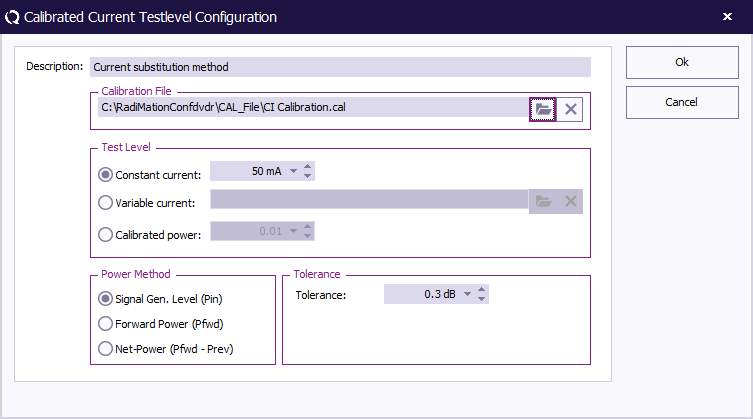
 Description Description
|
A field to enter a description for the calibrated current substitution method being configured.
|
 Calibration File Calibration File
|
A field to specify the calibration file path, which defines calibration settings for the current test level.
|
 Test Level Test Level
|
Section to configure the current test level for the test.
|
 Constant Current Constant Current
|
A test level option where the current is kept constant at a specified level, e.g., 50 mA.
|
 Variable Current Variable Current
|
An option to set a range or variable current level for testing, allowing dynamic adjustments during the test.
|
 Calibrated Power Calibrated Power
|
An option to set a calibrated power level for testing, which might be disabled if not applicable in the specific test configuration.
|
 Signal Gen. Level (Pin) Signal Gen. Level (Pin)
|
A power method that uses the signal generator level (Pin) as the reference for current measurement.
|
 Forward Power (Pfwd) Forward Power (Pfwd)
|
A power method that uses the forward power (Pfwd) as the reference for current measurement.
|
 Net-Power (Pfwd - Prev) Net-Power (Pfwd - Prev)
|
A power method that calculates net power by subtracting the previous power level (Prev) from the forward power (Pfwd).
|
 Tolerance Tolerance
|
A field to set a tolerance level for current measurement in dB, defining the acceptable variation range for the current test. For example, it could be set to 0.3 dB.
|
Test level: Voltage closed loop method[edit]
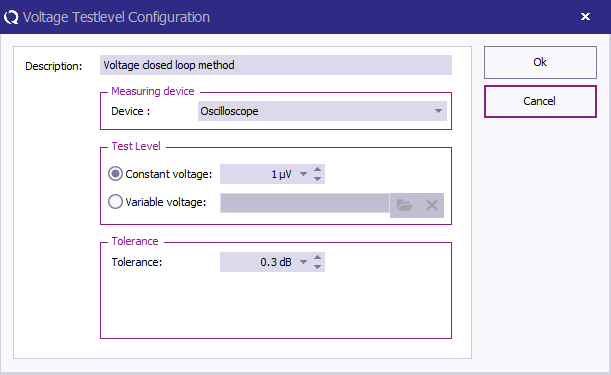
 Description Description
|
A field to enter a description for the voltage closed loop test level method being configured.
|
 Measuring Device Measuring Device
|
A dropdown menu to select the device used to measure the voltage, in this case, an Oscilloscope.
|
 Constant Voltage Constant Voltage
|
A test level option where the voltage is kept constant at a specified level, in this case, 1 µV.
|
 Variable Voltage Variable Voltage
|
An option to set a range or variable voltage level for testing. This option is disabled in the image.
|
 Tolerance Tolerance
|
A field to set a tolerance level for voltage measurement in dB, defining the acceptable variation range. In this case, it is set to 0.3 dB.
|
Test level: Voltage substitution method[edit]
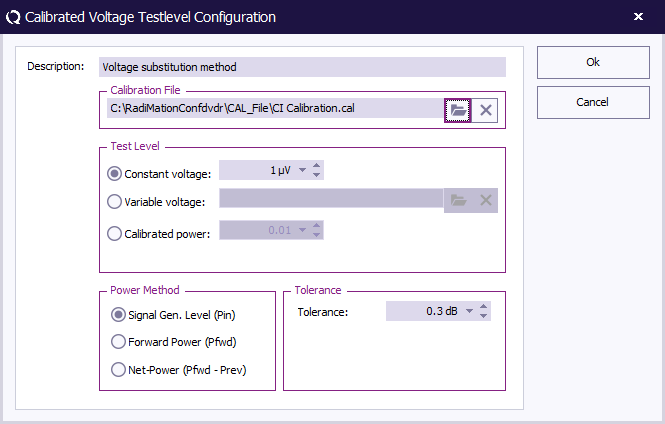
 Description Description
|
A field to enter a description for the calibrated voltage substitution method being configured.
|
 Calibration File Calibration File
|
A field to specify the calibration file path, which defines calibration settings for the voltage test level.
|
 Constant Voltage Constant Voltage
|
A test level option where the voltage is kept constant at a specified level, in this case, 1 µV.
|
 Variable Voltage Variable Voltage
|
An option to set a range or variable voltage level for testing. This option is disabled in the image.
|
 Calibrated Power Calibrated Power
|
An option to set a calibrated power level for testing, currently disabled.
|
 Signal Gen. Level (Pin) Signal Gen. Level (Pin)
|
A power method that uses the signal generator level (Pin) as the reference for voltage measurement.
|
 Forward Power (Pfwd) Forward Power (Pfwd)
|
A power method that uses the forward power (Pfwd) as the reference for voltage measurement.
|
 Net-Power (Pfwd - Prev) Net-Power (Pfwd - Prev)
|
A power method that calculates net power by subtracting the previous power level (Prev) from the forward power (Pfwd).
|
 Tolerance Tolerance
|
A field to set a tolerance level for voltage measurement in dB, defining the acceptable variation range. In this case, it is set to 0.3 dB.
|
Available Limits[edit]
Limit: Measured power limit[edit]
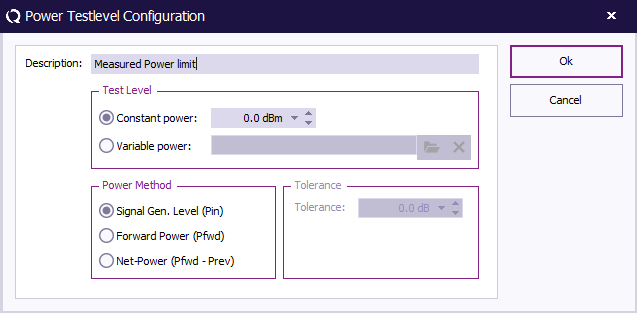
 Description Description
|
A field to enter a description for the power test level method being configured.
|
 Constant Power Constant Power
|
A test level option where the power is kept constant at a specified level, in this case, -100.0 dBm.
|
 Variable Power Variable Power
|
An option to set a range or variable power level for testing. This option is disabled in the image.
|
 Signal Gen. Level (Pin) Signal Gen. Level (Pin)
|
A power method that uses the signal generator level (Pin) as the reference for power measurement.
|
 Forward Power (Pfwd) Forward Power (Pfwd)
|
A power method that uses the forward power (Pfwd) as the reference for power measurement.
|
 Net-Power (Pfwd - Prev) Net-Power (Pfwd - Prev)
|
A power method that calculates net power by subtracting the previous power level (Prev) from the forward power (Pfwd).
|
 Tolerance Tolerance
|
A field to set a tolerance level for power measurement in dB, which defines the acceptable variation range.
|
Limit: Electrical field limit[edit]
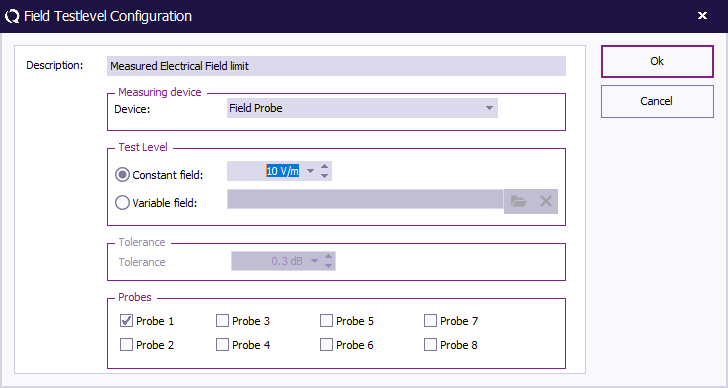
 Description Description
|
A field to enter a description for the field test level method being configured.
|
 Measuring Device Measuring Device
|
A dropdown menu to select the device used to measure the field, in this case, a Field Probe.
|
 Constant Field Constant Field
|
A test level option where the field strength is kept constant at a specified level, in this case, 1 V/m.
|
 Variable Field Variable Field
|
An option to set a range or variable field strength for testing. This option is disabled in the image.
|
 Tolerance Tolerance
|
A field to set a tolerance level for field strength measurement in dB, which defines the acceptable variation range. In this case, it is set to 0.3 dB.
|
 Probes Probes
|
A section to select from multiple probes (Probe 1 to Probe 8) for field measurement. Probe 1 and Probe 2 are selected in this image.
|
Limit: Measured current limit[edit]
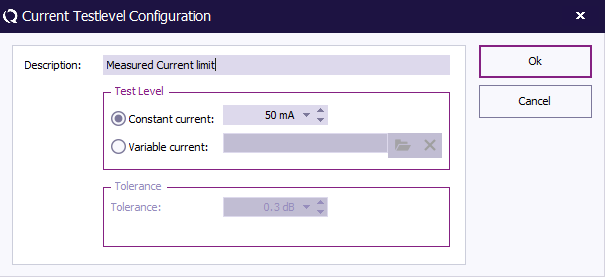
 Description Description
|
A field to enter a description for the current closed loop test level method being configured.
|
 Constant Current Constant Current
|
A test level option where the current is kept constant at a specified level, in this case, 50 mA.
|
 Variable Current Variable Current
|
An option to set a range or variable current level for testing. This option is disabled in the image.
|
 Tolerance Tolerance
|
A field to set a tolerance level for current measurement in dB, defining the acceptable variation range. In this case, it is set to 0.3 dB.
|
Limit: Calculated current limit[edit]
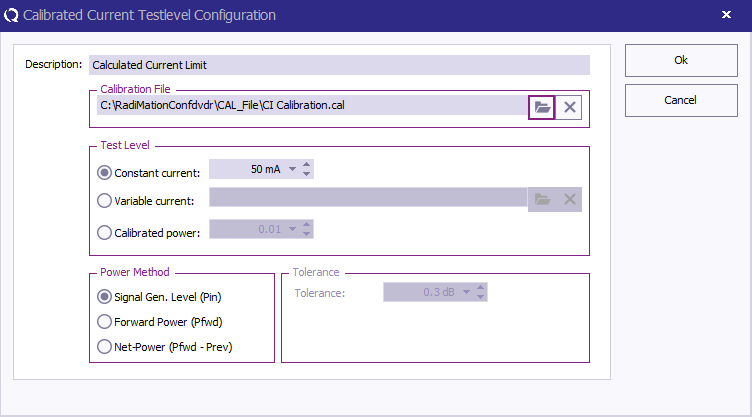
 Description Description
|
A field to enter a description for the calibrated current substitution method being configured.
|
 Calibration File Calibration File
|
A field to specify the calibration file path, which defines calibration settings for the current test level.
|
 Test Level Test Level
|
Section to configure the current test level for the test.
|
 Constant Current Constant Current
|
A test level option where the current is kept constant at a specified level, e.g., 50 mA.
|
 Variable Current Variable Current
|
An option to set a range or variable current level for testing, allowing dynamic adjustments during the test.
|
 Calibrated Power Calibrated Power
|
An option to set a calibrated power level for testing, which might be disabled if not applicable in the specific test configuration.
|
 Signal Gen. Level (Pin) Signal Gen. Level (Pin)
|
A power method that uses the signal generator level (Pin) as the reference for current measurement.
|
 Forward Power (Pfwd) Forward Power (Pfwd)
|
A power method that uses the forward power (Pfwd) as the reference for current measurement.
|
 Net-Power (Pfwd - Prev) Net-Power (Pfwd - Prev)
|
A power method that calculates net power by subtracting the previous power level (Prev) from the forward power (Pfwd).
|
 Tolerance Tolerance
|
A field to set a tolerance level for current measurement in dB, defining the acceptable variation range for the current test. For example, it could be set to 0.3 dB.
|
Limit: Measured voltage limit[edit]
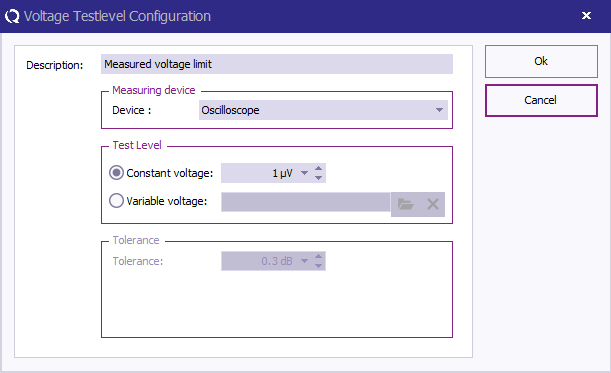
 Description Description
|
A field to enter a description for the voltage closed loop test level method being configured.
|
 Measuring Device Measuring Device
|
A dropdown menu to select the device used to measure the voltage, in this case, an Oscilloscope.
|
 Constant Voltage Constant Voltage
|
A test level option where the voltage is kept constant at a specified level, in this case, 1 µV.
|
 Variable Voltage Variable Voltage
|
An option to set a range or variable voltage level for testing. This option is disabled in the image.
|
 Tolerance Tolerance
|
A field to set a tolerance level for voltage measurement in dB, defining the acceptable variation range. In this case, it is set to 0.3 dB.
|
Limit: Calculated voltage[edit]
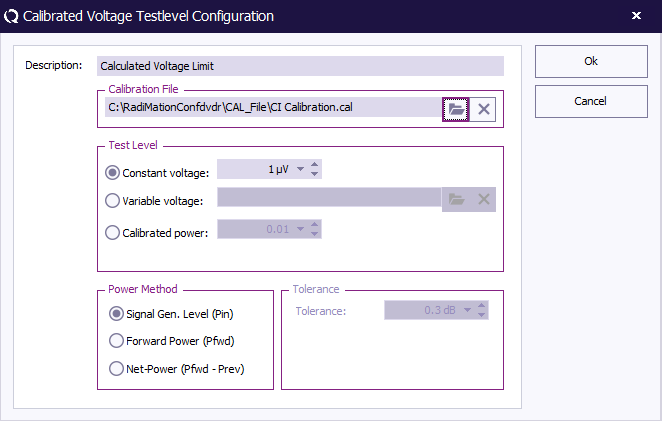
 Description Description
|
A field to enter a description for the calibrated voltage substitution method being configured.
|
 Calibration File Calibration File
|
A field to specify the calibration file path, which defines calibration settings for the voltage test level.
|
 Constant Voltage Constant Voltage
|
A test level option where the voltage is kept constant at a specified level, in this case, 1 µV.
|
 Variable Voltage Variable Voltage
|
An option to set a range or variable voltage level for testing. This option is disabled in the image.
|
 Calibrated Power Calibrated Power
|
An option to set a calibrated power level for testing, currently disabled.
|
 Signal Gen. Level (Pin) Signal Gen. Level (Pin)
|
A power method that uses the signal generator level (Pin) as the reference for voltage measurement.
|
 Forward Power (Pfwd) Forward Power (Pfwd)
|
A power method that uses the forward power (Pfwd) as the reference for voltage measurement.
|
 Net-Power (Pfwd - Prev) Net-Power (Pfwd - Prev)
|
A power method that calculates net power by subtracting the previous power level (Prev) from the forward power (Pfwd).
|
 Tolerance Tolerance
|
A field to set a tolerance level for voltage measurement in dB, defining the acceptable variation range. In this case, it is set to 0.3 dB.
|
Limit: Magnetic field limit[edit]
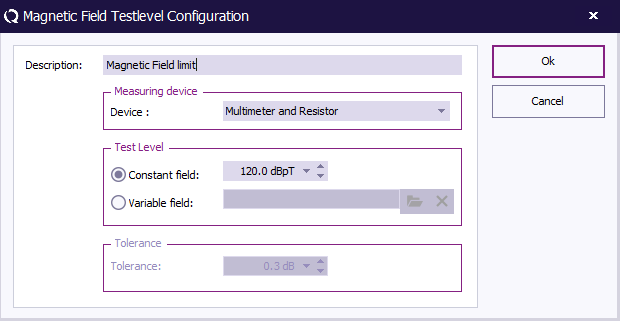
 Description Description
|
A field to enter a description for the magnetic field test level method being configured.
|
 Measuring Device Measuring Device
|
A dropdown menu to select the device used to measure the magnetic field, in this case, a Multimeter and Resistor.
|
 Constant Field Constant Field
|
A test level option where the magnetic field strength is kept constant at a specified level, in this case, 120.0 dBpT.
|
 Variable Field Variable Field
|
An option to set a range or variable magnetic field strength for testing. This option is disabled in the image.
|
 Tolerance Tolerance
|
A field to set a tolerance level for magnetic field measurement in dB, defining the acceptable variation range. In this case, it is set to 0.3 dB.
|
Limit: Minimum performance limit[edit]

 Description Description
|
A field to enter a description for the minimum performance test level being configured.
|
 Stepdown Value Stepdown Value
|
A field to set the stepdown value, which specifies the amount by which the test level will decrease in each step. The default value is set to 0.2 dB.
|
Available Inputs[edit]
Input: Power[edit]
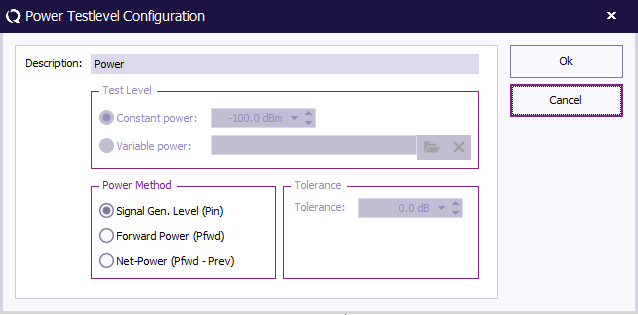
 Description Description
|
A field to enter a description for the power test level method being configured.
|
 Constant Power Constant Power
|
A test level option where the power is kept constant at a specified level, in this case, -100.0 dBm.
|
 Variable Power Variable Power
|
An option to set a range or variable power level for testing. This option is disabled in the image.
|
 Signal Gen. Level (Pin) Signal Gen. Level (Pin)
|
A power method that uses the signal generator level (Pin) as the reference for power measurement.
|
 Forward Power (Pfwd) Forward Power (Pfwd)
|
A power method that uses the forward power (Pfwd) as the reference for power measurement.
|
 Net-Power (Pfwd - Prev) Net-Power (Pfwd - Prev)
|
A power method that calculates net power by subtracting the previous power level (Prev) from the forward power (Pfwd).
|
 Tolerance Tolerance
|
A field to set a tolerance level for power measurement in dB, which defines the acceptable variation range.
|
Input: Electrical field probe[edit]
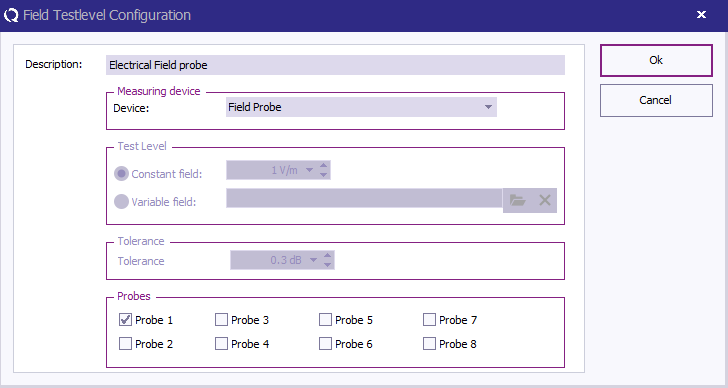
 Description Description
|
A field to enter a description for the field test level method being configured.
|
 Measuring Device Measuring Device
|
A dropdown menu to select the device used to measure the field, in this case, a Field Probe.
|
 Constant Field Constant Field
|
A test level option where the field strength is kept constant at a specified level, in this case, 1 V/m.
|
 Variable Field Variable Field
|
An option to set a range or variable field strength for testing. This option is disabled in the image.
|
 Tolerance Tolerance
|
A field to set a tolerance level for field strength measurement in dB, which defines the acceptable variation range. In this case, it is set to 0.3 dB.
|
 Probes Probes
|
A section to select from multiple probes (Probe 1 to Probe 8) for field measurement. Probe 1 and Probe 2 are selected in this image.
|
Input: Calculated electrical field calibration[edit]
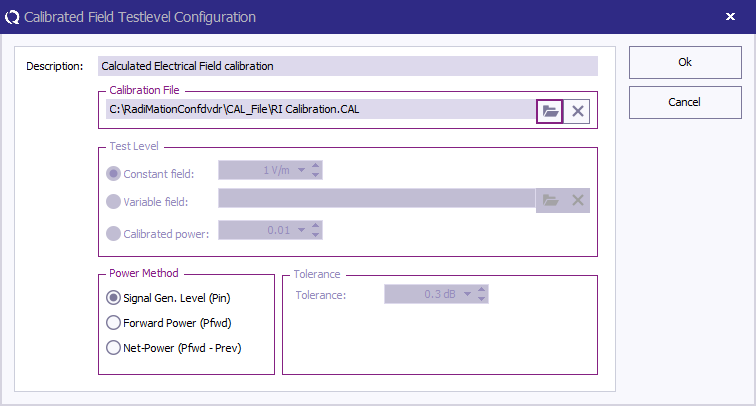
 Description Description
|
A field to enter a description for the calibrated field test level method being configured.
|
 Calibration File Calibration File
|
A field to specify the calibration file path, which defines calibration settings for the test level.
|
 Constant Field Constant Field
|
A test level option where the field strength is kept constant at a specified level, in this case, 1 V/m.
|
 Variable Field Variable Field
|
An option to set a range or variable field strength for testing. This option is disabled in the image.
|
 Calibrated Power Calibrated Power
|
An option to set a calibrated power level for testing, currently disabled.
|
 Signal Gen. Level (Pin) Signal Gen. Level (Pin)
|
A power method that uses the signal generator level (Pin) as the reference for field strength measurement.
|
 Forward Power (Pfwd) Forward Power (Pfwd)
|
A power method that uses the forward power (Pfwd) as the reference for field strength measurement.
|
 Net-Power (Pfwd - Prev) Net-Power (Pfwd - Prev)
|
A power method that calculates net power by subtracting the previous power level (Prev) from the forward power (Pfwd).
|
 Tolerance Tolerance
|
A field to set a tolerance level for field strength measurement in dB, which defines the acceptable variation range. In this case, it is set to 0.3 dB.
|
Input: Current sensor[edit]
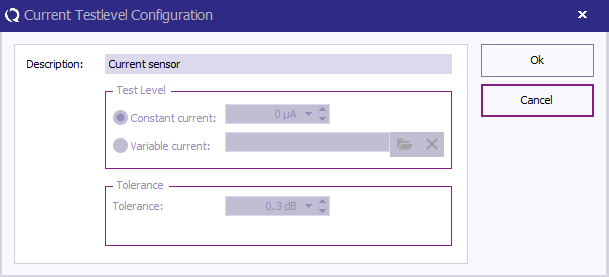
 Description Description
|
A field to enter a description for the current closed loop test level method being configured.
|
 Constant Current Constant Current
|
A test level option where the current is kept constant at a specified level, in this case, 50 mA.
|
 Variable Current Variable Current
|
An option to set a range or variable current level for testing. This option is disabled in the image.
|
 Tolerance Tolerance
|
A field to set a tolerance level for current measurement in dB, defining the acceptable variation range. In this case, it is set to 0.3 dB.
|
Input: Calculated current[edit]
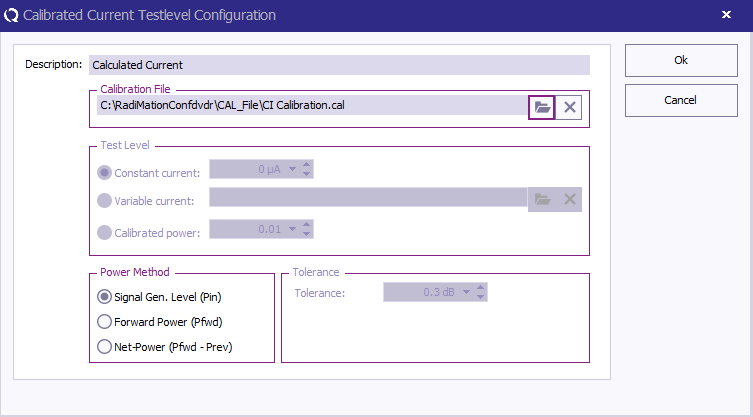
 Description Description
|
A field to enter a description for the calibrated current substitution method being configured.
|
 Calibration File Calibration File
|
A field to specify the calibration file path, which defines calibration settings for the current test level.
|
 Test Level Test Level
|
Section to configure the current test level for the test.
|
 Constant Current Constant Current
|
A test level option where the current is kept constant at a specified level, e.g., 50 mA.
|
 Variable Current Variable Current
|
An option to set a range or variable current level for testing, allowing dynamic adjustments during the test.
|
 Calibrated Power Calibrated Power
|
An option to set a calibrated power level for testing, which might be disabled if not applicable in the specific test configuration.
|
 Signal Gen. Level (Pin) Signal Gen. Level (Pin)
|
A power method that uses the signal generator level (Pin) as the reference for current measurement.
|
 Forward Power (Pfwd) Forward Power (Pfwd)
|
A power method that uses the forward power (Pfwd) as the reference for current measurement.
|
 Net-Power (Pfwd - Prev) Net-Power (Pfwd - Prev)
|
A power method that calculates net power by subtracting the previous power level (Prev) from the forward power (Pfwd).
|
 Tolerance Tolerance
|
A field to set a tolerance level for current measurement in dB, defining the acceptable variation range for the current test. For example, it could be set to 0.3 dB.
|
Input: Voltage measurement[edit]
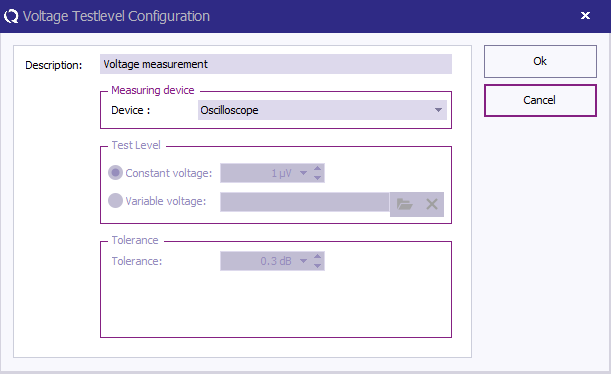
 Description Description
|
A field to enter a description for the voltage closed loop test level method being configured.
|
 Measuring Device Measuring Device
|
A dropdown menu to select the device used to measure the voltage, in this case, an Oscilloscope.
|
 Constant Voltage Constant Voltage
|
A test level option where the voltage is kept constant at a specified level, in this case, 1 µV.
|
 Variable Voltage Variable Voltage
|
An option to set a range or variable voltage level for testing. This option is disabled in the image.
|
 Tolerance Tolerance
|
A field to set a tolerance level for voltage measurement in dB, defining the acceptable variation range. In this case, it is set to 0.3 dB.
|
Input: Calculated voltage[edit]
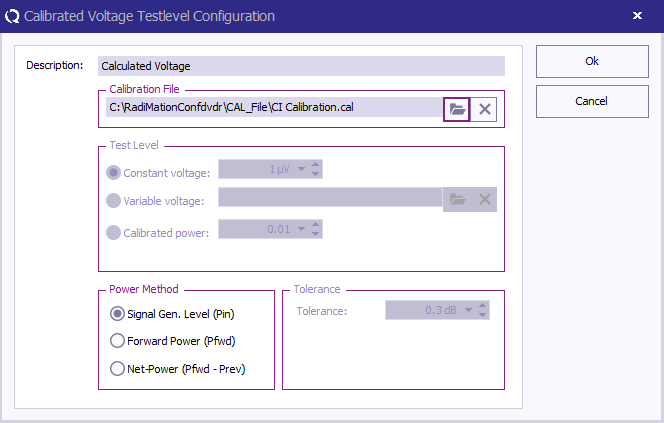
 Description Description
|
A field to enter a description for the calibrated voltage substitution method being configured.
|
 Calibration File Calibration File
|
A field to specify the calibration file path, which defines calibration settings for the voltage test level.
|
 Constant Voltage Constant Voltage
|
A test level option where the voltage is kept constant at a specified level, in this case, 1 µV.
|
 Variable Voltage Variable Voltage
|
An option to set a range or variable voltage level for testing. This option is disabled in the image.
|
 Calibrated Power Calibrated Power
|
An option to set a calibrated power level for testing, currently disabled.
|
 Signal Gen. Level (Pin) Signal Gen. Level (Pin)
|
A power method that uses the signal generator level (Pin) as the reference for voltage measurement.
|
 Forward Power (Pfwd) Forward Power (Pfwd)
|
A power method that uses the forward power (Pfwd) as the reference for voltage measurement.
|
 Net-Power (Pfwd - Prev) Net-Power (Pfwd - Prev)
|
A power method that calculates net power by subtracting the previous power level (Prev) from the forward power (Pfwd).
|
 Tolerance Tolerance
|
A field to set a tolerance level for voltage measurement in dB, defining the acceptable variation range. In this case, it is set to 0.3 dB.
|
Input Test level: VSWR[edit]

-
 Description The description of the input.
Description The description of the input.
Calculation[edit]
The VSWR (Voltage Standing Wave Ratio) test level in RadiMation is a measurement that indicates how well the energy from a signal source is being transferred to a device under test. It provides insight into the efficiency of power delivery, with a lower VSWR indicating better efficiency and minimal energy reflection. This is important in electromagnetic immunity testing to ensure accurate power application across test frequencies.
In RadiMation, the VSWR is calculated based on the Return Loss (RL) between the forward power and reflected power.
- Calculate Return Loss (RL):

In RadiMation, this is calculated as the difference between the forward power and the reflected power.
- Calculate the Reflection Coefficient:

The reflection coefficient is a value derived from the Return Loss. It quantifies the proportion of energy reflected from the device.

If the reflection coefficient is 1 (meaning full reflection with no power transfer), the VSWR is set to a high value (e.g., 1000) to represent an infinite VSWR.
VSWR measures the standing wave pattern created by the interference between the forward and reflected waves. It’s calculated based on the reflection coefficient as follows:
Input: Magnetic field[edit]
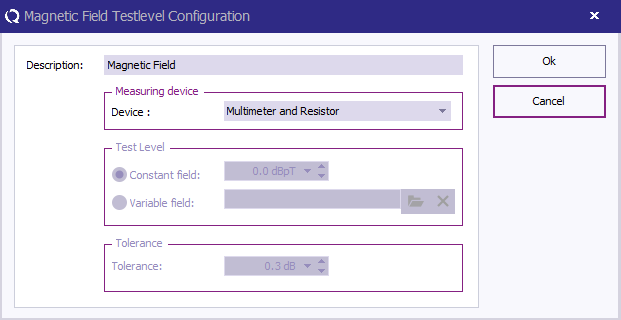
 Description Description
|
A field to enter a description for the magnetic field test level method being configured.
|
 Measuring Device Measuring Device
|
A dropdown menu to select the device used to measure the magnetic field, in this case, a Multimeter and Resistor.
|
 Constant Field Constant Field
|
A test level option where the magnetic field strength is kept constant at a specified level, in this case, 120.0 dBpT.
|
 Variable Field Variable Field
|
An option to set a range or variable magnetic field strength for testing. This option is disabled in the image.
|
 Tolerance Tolerance
|
A field to set a tolerance level for magnetic field measurement in dB, defining the acceptable variation range. In this case, it is set to 0.3 dB.
|
Input: Calculated magnetic field[edit]
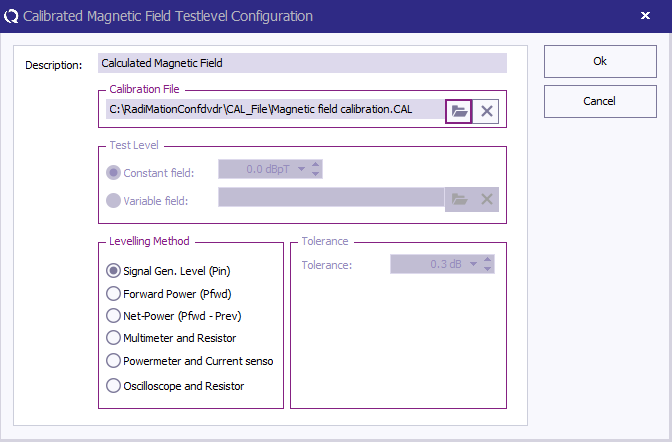
 Description Description
|
A field to enter a description for the calibrated magnetic field test level method being configured.
|
 Calibration File Calibration File
|
A field to specify the calibration file path, which defines calibration settings for the magnetic field test level.
|
 Constant Field Constant Field
|
A test level option where the magnetic field strength is kept constant at a specified level, in this case, 120.0 dBpT.
|
 Variable Field Variable Field
|
An option to set a range or variable magnetic field strength for testing. This option is disabled in the image.
|
 Signal Gen. Level (Pin) Signal Gen. Level (Pin)
|
A leveling method that uses the signal generator level (Pin) as the reference for magnetic field strength measurement.
|
 Forward Power (Pfwd) Forward Power (Pfwd)
|
A leveling method that uses the forward power (Pfwd) as the reference for magnetic field strength measurement.
|
 Net-Power (Pfwd - Prev) Net-Power (Pfwd - Prev)
|
A leveling method that calculates net power by subtracting the previous power level (Prev) from the forward power (Pfwd).
|
 Multimeter and Resistor Multimeter and Resistor
|
A leveling method that utilizes a multimeter and resistor to measure magnetic field strength.
|
 Powermeter and Current Sensor Powermeter and Current Sensor
|
A leveling method that uses a powermeter and current sensor to measure magnetic field strength.
|
 Oscilloscope and Resistor Oscilloscope and Resistor
|
A leveling method that uses an oscilloscope and resistor for magnetic field strength measurement.
|
 Tolerance Tolerance
|
A field to set a tolerance level for magnetic field measurement in dB, defining the acceptable variation range. In this case, it is set to 0.3 dB.
|
 Tests
Tests
 Conducted Immunity
Conducted Immunity
 Substitution
Substitution  Tests
Tests
 Conducted Immunity
Conducted Immunity
 Fixed Current
Fixed Current  Tests
Tests
 Conducted Immunity
Conducted Immunity
 Fixed Power
Fixed Power  Tests
Tests
 Conducted Immunity
Conducted Immunity
 Minimum Performance
Minimum Performance  Description The description of the input.
Description The description of the input.





























